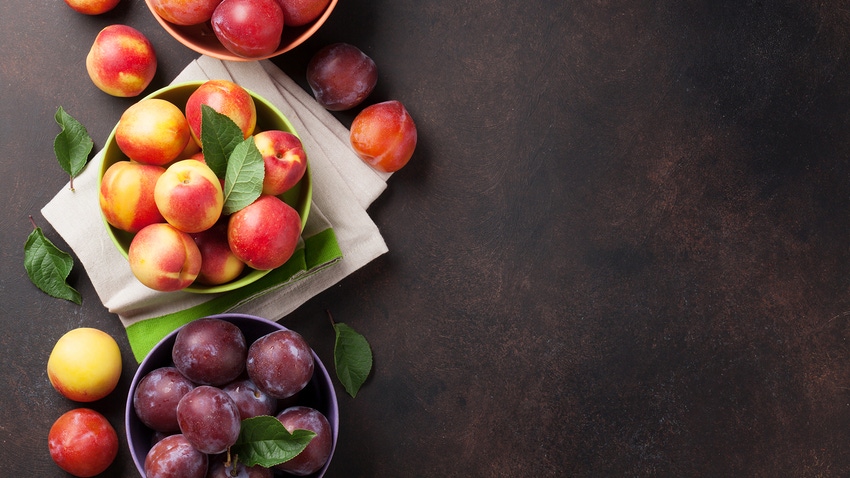Peaches, plums, nectarines are being investigated for listeria contamination
FDA is investigating two unrelated foodborne illness outbreaks, one involving three stone fruits contaminated with listeria and the other involving cantaloupes contaminated with salmonella.

At a Glance
- FDA is investigating two unrelated foodborne illness outbreaks, one involving stone fruits and another involving cantaloupes.
- Recalled stone fruit may implicate major retailers such as Publix, Walmart Inc., Sam’s Club and Albertsons Co. banner stores.
- Listeria has the ability to survive on stone fruits throughout the handling, storage and transportation chain.
Two unrelated food illness outbreaks are under investigation by FDA. Cantaloupes are being recalled for possible salmonella contamination. Stone fruits are being investigated for Listeria monocytogenes. Aside from timing, there is no similarity between the sources of the outbreaks. While it is unlikely that fresh fruit is currently being sold, all implicated fruit has the potential to be available in frozen form.
Peaches, plums and nectarines sold in retail stores from May 1 through Nov. 15, 2022, and May 1 through Nov. 15, 2023, have the potential to be contaminated with Listeria monocytogenes. The fruits were sold as individual pieces or packaged in bags under various brand names, including HMC Farms and Signature Farms. While recalled fresh fruit is past its expiration date, the fruit was sold to other manufacturers who may have frozen and/or relabeled the fruit for resale, including Publix, Walmart Inc., Sam’s Club, Sprouts Farmers Market, and select Aldi stores and Albertsons Co. banner stores.
As of the most recent update on Nov. 21, CDC reported 11 illnesses in seven states. Ten people have been hospitalized and one person died.
It’s likely the pathogen spread in the packinghouse. In 2014 and 2015, a multistate outbreak of Listeria monocytogenes was linked to whole apples. Bacterial isolates were obtained from environmental samples taken from the grower’s packing facility and distribution chain apples.
A similar situation involving peaches in 2014 led researchers to study the survival of Listeria monocytogenes on peaches and nectarines. “Stone fruit, including peaches, nectarines, plums and pluots are generally considered as low-risk fruit for foodborne illnesses,” the authors wrote. “This first reported link between human listeriosis and stone fruit highlights a potentially new food vehicle in the transmission of Listeria monocytogenes. In addition, this outbreak also demonstrates the pathogen’s ability to persist and survive on stone fruits through the handling, storage and transportation chain. Pathogen presence on the fruit’s surface indicates that inadequate hygienic conditions were employed during harvesting, processing and/or transportation.”
Trevor Suslow, Ph.D., professor of cooperative extension and applied research for preharvest to postharvest quality and safety at University of California, Davis, said both listeria and equipment cross-contamination were involved in these outbreaks. An outbreak in Chile revealed similar issues with packing line contamination.
“The contamination of stone fruit by genomically highly related isolates of Listeria monocytogenes, recovered from known human cases and product which, according to the available CDC information, appears to span multiple years,” he explained. “As a rule, the first and simplest explanation is a deeply established harborage site(s) within a primary packing facility. Recent research has certainly established alternative possibilities for repeated but episodic introduction of a very genetically stable strain from external environmental sources in a region. Publicly available insights are very limited, but it is most sensible to focus on all postharvest handling steps.”
Listeria monocytogenes is a true environmental bacterium and can survive and grow without passing through an animal host. “Sources can be waterways, soil, decaying vegetation, and many other farm, pasture, slough, rural or urban environments,” Suslow said. “It can also be shed in animal feces. Whatever the source(s), Listeria monocytogenes has been repeatedly demonstrated to establish in harborage sites in tree fruit packing operations, including peaches, plums and nectarines.
“Publicly, we simply do not know the circumstances or any investigative particulars at this time,” he continued. “However, transfer of Listeria monocytogenes cells or aggregates from deep recesses in fruit handling and packing equipment to fruit surfaces over periods of time across the marketing season seem a straightforward first approach to developing an outbreak-specific understanding leading to improved food safety systems.”
Listeria monocytogenes is an unusual bacterium because it thrives in cold, moist environments. If contaminated food is cut and refrigerated, listeria is given the ideal conditions for population growth.
Symptoms of infection depend on the individual. Pregnant women, newborns, adults ages 65 or older and those with weakened immune systems are most vulnerable. Intestinal illness usually develops within 24 hours and can last one to three days with diarrhea and vomiting. If the infection becomes invasive, symptoms mimic the flu with muscle aches and fatigue. In pregnant women, miscarriages and stillbirths are likely. In nonpregnant people, about 1 in 20 people who are infected die.
About the Author(s)
You May Also Like






